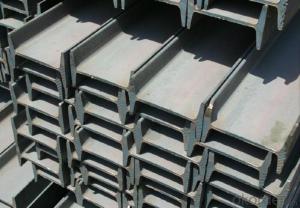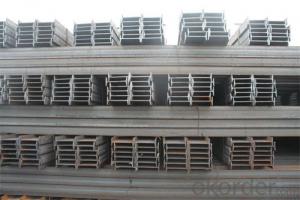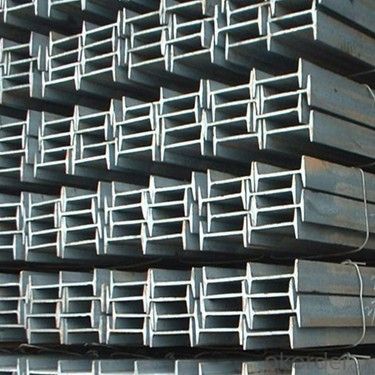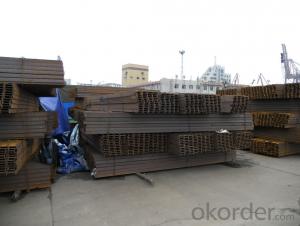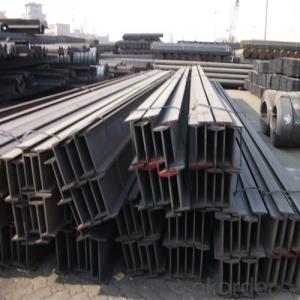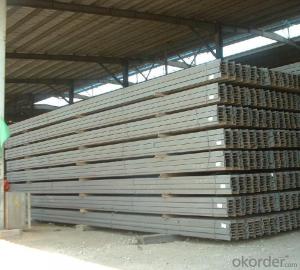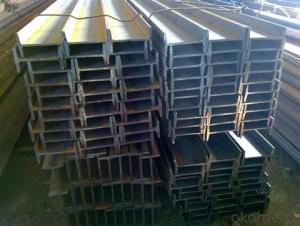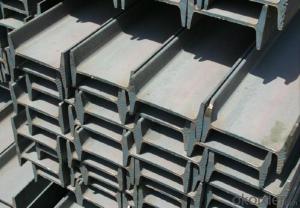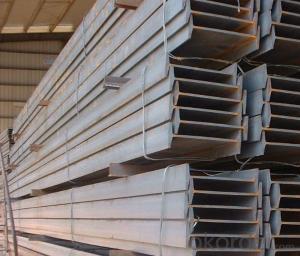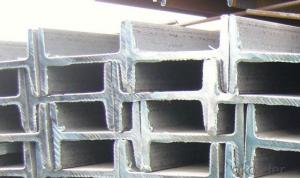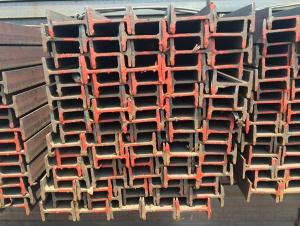Hot Rolled Steel of Q235B IPEAA80 for Construction Steel I-Beams
- Loading Port:
- Tianjin
- Payment Terms:
- TT or LC
- Min Order Qty:
- 25 m.t.
- Supply Capability:
- 100000 m.t./month
OKorder Service Pledge
OKorder Financial Service
You Might Also Like
OKorder is offering high quality Hot Rolled Steel I-Beams at great prices with worldwide shipping. Our supplier is a world-class manufacturer of steel, with our products utilized the world over. OKorder annually supplies products to European, North American and Asian markets. We provide quotations within 24 hours of receiving an inquiry and guarantee competitive prices.
Product Applications:
1. Supporting members, most commonly in the house raising industry to strengthen timber bears under houses. Transmission line towers, etc
2. Prefabricated structure
3. Medium scale bridges
4. It is widely used in various building structures and engineering structures such as roof beams, bridges, transmission towers, hoisting machinery and transport machinery, ships, industrial furnaces, reaction tower, container frame and warehouse etc.
Product Advantages:
OKorder's Steel I-Beams are durable, strong, and resist corrosion.
OKorder is offering high quality Hot Rolled Steel I-Beams at great prices with worldwide shipping. Our supplier is a world-class manufacturer of steel, with our products utilized the world over. OKorder annually supplies products to European, North American and Asian markets. We provide quotations within 24 hours of receiving an inquiry and guarantee competitive prices.
Product Applications:
1. Supporting members, most commonly in the house raising industry to strengthen timber bears under houses. Transmission line towers, etc
2. Prefabricated structure
3. Medium scale bridges
4. It is widely used in various building structures and engineering structures such as roof beams, bridges, transmission towers, hoisting machinery and transport machinery, ships, industrial furnaces, reaction tower, container frame and warehouse etc.
OKorder is offering high quality Hot Rolled Steel I-Beams at great prices with worldwide shipping. Our supplier is a world-class manufacturer of steel, with our products utilized the world over. OKorder annually supplies products to European, North American and Asian markets. We provide quotations within 24 hours of receiving an inquiry and guarantee competitive prices.
Product Applications:
1. Supporting members, most commonly in the house raising industry to strengthen timber bears under houses. Transmission line towers, etc
2. Prefabricated structure
3. Medium scale bridges
4. It is widely used in various building structures and engineering structures such as roof beams, bridges, transmission towers, hoisting machinery and transport machinery, ships, industrial furnaces, reaction tower, container frame and warehouse etc.
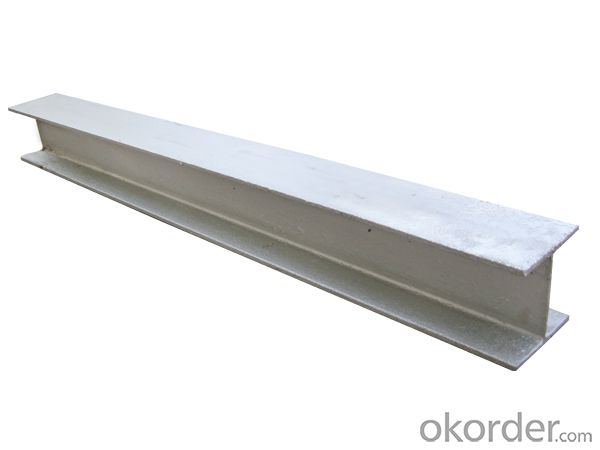
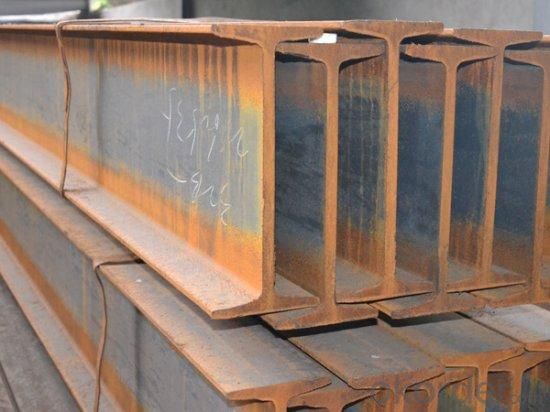
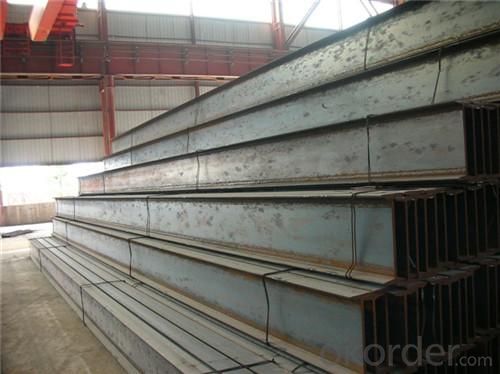
- Q: What is the supply length of 30# I-beam?
- The supply length of 30# I-beam is usually 12 meters. The length of the steel bar is generally 9m and 12m; the length of the I-beam and H section steel is generally 12m; the factory length of the angle steel is generally 6 meters; the common length of the channel steel is 6 meters, /8 meters and /9 meters.
- Q: What is the typical lifespan of steel I-beams?
- The typical lifespan of steel I-beams can vary depending on various factors such as the quality of the steel, environmental conditions, and maintenance practices. However, with proper care and maintenance, steel I-beams can last for several decades or even a century.
- Q: What are the common design considerations when using steel I-beams?
- Some common design considerations when using steel I-beams include determining the appropriate size and shape of the beam based on the structural load it needs to support, calculating the required strength and stiffness to ensure structural stability, considering the potential for deflection and buckling under load, and incorporating appropriate connections and supports to ensure proper installation and performance. Additionally, factors such as fire resistance, corrosion protection, and cost-effectiveness may also be taken into account during the design process.
- Q: How do you calculate the maximum allowable deflection for a steel I-beam?
- In order to determine the maximum allowable deflection for a steel I-beam, various factors must be taken into consideration. First and foremost, the beam's modulus of elasticity (E) and moment of inertia (I) need to be determined. The modulus of elasticity measures the material's stiffness, while the moment of inertia represents the beam's resistance to bending. These figures can be obtained from engineering handbooks or the manufacturer's specifications. Subsequently, the maximum allowable deflection for the beam should be determined, which is typically specified by a building code or design standard. This value is commonly expressed as a fraction of the beam's span length (L). For example, a typical limit for maximum allowable deflection is L/360, where L represents the span length. Once the modulus of elasticity, moment of inertia, and maximum allowable deflection are known, the formula for beam deflection (δ) can be utilized to calculate the maximum allowable deflection. The formula is as follows: δ = (5 * w * L^4) / (384 * E * I) where w denotes the uniform load applied to the beam. By substituting the known values into the equation, the maximum allowable deflection can be determined. It is important to note that this calculation assumes the beam is exposed to a uniformly distributed load and does not account for any additional loads or safety factors that may be necessary for your specific application.
- Q: What are the common welding techniques used for steel I-beams?
- The common welding techniques used for steel I-beams include shielded metal arc welding (SMAW), gas metal arc welding (GMAW), and flux-cored arc welding (FCAW). These methods ensure strong and secure welds between the different sections of the I-beams, allowing them to withstand heavy loads and maintain structural integrity.
- Q: How do steel I-beams perform in areas with high seismic activity?
- Steel I-beams are widely recognized for their excellent performance in areas with high seismic activity. The combination of their structural properties and inherent strength makes them highly suitable for withstanding earthquakes and other seismic events. Firstly, steel I-beams have a high strength-to-weight ratio, which means they can withstand significant loads without being excessively heavy. This characteristic is especially crucial in seismic zones, as it allows structures to be designed with the necessary strength while minimizing their overall weight. The lighter the structure, the lower the seismic forces it will experience during an earthquake. Moreover, steel I-beams possess excellent ductility, which is the ability to deform under stress without losing their overall strength. When subjected to a seismic event, these beams can absorb and dissipate seismic energy through controlled yielding and plastic deformation. This ductile behavior helps prevent catastrophic failure by allowing the structure to flex and absorb the forces generated by the earthquake, effectively reducing the risk of collapse. Additionally, steel has a high tensile strength, meaning it can resist pulling forces. This property is particularly advantageous during seismic events, as it helps the I-beams resist the lateral forces and ground motion generated by earthquakes. Steel's ability to distribute these forces throughout the structure helps minimize localized damage and ensures the overall stability of the building. Furthermore, steel I-beams can be easily reinforced or retrofitted to enhance their performance in high seismic areas. Additional measures, such as the use of diagonal bracing, cross-bracing, or shear walls, can further increase the structural integrity and resilience of the building. In conclusion, steel I-beams perform exceptionally well in areas with high seismic activity. Their strength, ductility, and ability to resist lateral forces make them an ideal choice for seismic-resistant construction. By incorporating steel I-beams into the design of buildings, engineers can enhance the safety and durability of structures in seismic zones, reducing the risk of damage or collapse during earthquakes.
- Q: How do steel I-beams perform in terms of electromagnetic interference (EMI) shielding?
- Steel I-beams are known for their strength and durability, but when it comes to electromagnetic interference (EMI) shielding, they do not offer significant protection. Steel, being a good conductor of electricity, can actually amplify electromagnetic fields rather than blocking them. Therefore, steel I-beams are not effective in reducing electromagnetic interference.
- Q: Can steel I-beams be used for educational institutions?
- Yes, steel I-beams can be used for educational institutions. Steel I-beams are commonly used in construction due to their high strength and load-bearing capabilities. They can provide structural support for buildings, including educational institutions, ensuring safety and stability. Additionally, steel I-beams offer design flexibility, allowing for spacious and open interior spaces within educational buildings.
- Q: Can steel I-beams be used in historical building preservation projects?
- Historical building preservation projects can indeed incorporate steel I-beams. These beams are commonly employed as supportive structural elements in buildings due to their exceptional strength and durability. When preserving historical buildings, it becomes crucial to strike a balance between maintaining their original aesthetic and historical significance while ensuring structural integrity. In numerous instances, integrating steel I-beams can effectively reinforce and stabilize the building, guaranteeing its longevity while still preserving its historical value. Additionally, these beams can be discreetly concealed within the structure or seamlessly integrated into the design, minimizing their visual impact on the building's historic features. Ultimately, the inclusion of steel I-beams in historical building preservation projects necessitates careful consideration and evaluation on a case-by-case basis to achieve the optimal outcome in terms of both structural stability and the preservation of the building's architectural heritage.
- Q: Can steel I-beams be used for both residential and commercial construction?
- Yes, steel I-beams can be used for both residential and commercial construction. They are commonly used in both types of construction due to their strength, durability, and ability to support heavy loads.
Send your message to us
Hot Rolled Steel of Q235B IPEAA80 for Construction Steel I-Beams
- Loading Port:
- Tianjin
- Payment Terms:
- TT or LC
- Min Order Qty:
- 25 m.t.
- Supply Capability:
- 100000 m.t./month
OKorder Service Pledge
OKorder Financial Service
Similar products
Hot products
Hot Searches
Related keywords

